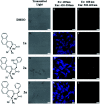Boron Schiff bases derived from α-amino acids as nucleoli/cytoplasm cell-staining fluorescent probes in vitro
- PMID: 35518166
- PMCID: PMC9056538
- DOI: 10.1039/d0ra05948j
Boron Schiff bases derived from α-amino acids as nucleoli/cytoplasm cell-staining fluorescent probes in vitro
Abstract
The size, shape, and number of nucleoli in a cell's nucleus might help to distinguish a malignant from a benign tumor. Cellular biology and histopathology often require better visualization to understand nucleoli-related processes, thus organelle-specific fluorescent markers are needed. Here, we report the design, synthesis, and fully chemo-photophysical characterization of fluorescent boron Schiff bases (BOSCHIBAs), derived from α-amino acids (i.e., phenylalanine, tyrosine and tryptophan), with nucleoli- and cytoplasm-specific staining in cells. It is the first time that Boron Schiff bases derived from α-amino acids act as notorious dual (nucleoli and cytoplasm) cell-staining fluorescent probes. The boron derivatives not only showed good photostability and acceptable quantum yields (∼5%) in solution, but also exhibited low cytotoxicity (>90% cell viability at 0.1 and 1 μg mL-1), which make them good candidates to be used in medical diagnosis.
This journal is © The Royal Society of Chemistry.
Conflict of interest statement
There are no conflicts to declare.
Figures












Similar articles
-
Organotin Dyes Bearing Anionic Boron Clusters as Cell-Staining Fluorescent Probes.Chemistry. 2018 Apr 11;24(21):5601-5612. doi: 10.1002/chem.201705804. Epub 2018 Mar 8. Chemistry. 2018. PMID: 29338104
-
Fluorescent Molecular Rotors of Organoboron Compounds from Schiff Bases: Synthesis, Viscosity, Reversible Thermochromism, Cytotoxicity, and Bioimaging Cells.J Org Chem. 2017 Mar 3;82(5):2375-2385. doi: 10.1021/acs.joc.6b02802. Epub 2017 Feb 16. J Org Chem. 2017. PMID: 28135091
-
Organotin Schiff bases as halofluorochromic dyes: green synthesis, chemio-photophysical characterization, DFT, and their fluorescent bioimaging in vitro.J Mater Chem B. 2021 Sep 29;9(37):7698-7712. doi: 10.1039/d1tb01405f. J Mater Chem B. 2021. PMID: 34586143
-
Fluorescent Probes for Sensing and Imaging within Specific Cellular Organelles.Acc Chem Res. 2016 Oct 18;49(10):2115-2126. doi: 10.1021/acs.accounts.6b00292. Epub 2016 Sep 23. Acc Chem Res. 2016. PMID: 27661761 Review.
-
Schiff Bases and their Metal Complexes as Potential Anticancer Candidates: A Review of Recent Works.Anticancer Agents Med Chem. 2019;19(15):1786-1795. doi: 10.2174/1871520619666190227171716. Anticancer Agents Med Chem. 2019. PMID: 30827264 Review.
Cited by
-
Investigation of antileishmanial, antioxidant activities, CT-DNA interaction and DFT study of novel cobalt(II) complexes derived from mesogenic aromatic amino acids based Schiff base ligands.Biometals. 2024 Dec;37(6):1575-1597. doi: 10.1007/s10534-024-00627-9. Epub 2024 Aug 18. Biometals. 2024. PMID: 39154301
References
LinkOut - more resources
Full Text Sources

